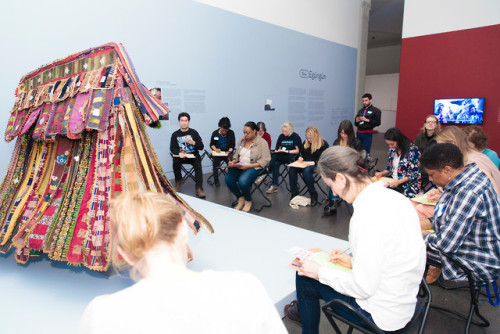When I’m teaching from the Brooklyn Museum’s egúngún masquerade costume, t
When I’m teaching from the Brooklyn Museum’s egúngún masquerade costume, the first thing students notice is its scale: the life-sized work, over five feet wide and nearly as tall, has a monumental and imposing presence. As they zoom in, they begin to appreciate the complexities of the costume’s construction—intricate fabrics, cut and sewn into patterned strips, dozens of which are layered over one another creating a dense, multi-layered surface. The more we look, the more questions begin to emerge: Where does this come from, and how did it end up in the Brooklyn Museum? Who would have worn it, and why? Where did the fabrics come from, and what, if anything, do they symbolize?As an educator, I hear questions like these all the time, but all too often, I can only respond in broad strokes or with speculation. Given this context, I was immediately excited to teach from the special exhibition One: Egúngún. The exhibition focuses entirely on a single egúngún masquerade costume in our collection, situating it within a nuanced, and specific, context. Wall texts, videos, and textiles displayed alongside the egúngún tell a more holistic story about the work, offering insight into how, when, and why it was made. Building on the exhibition’s multifaceted approach to research and display, the Education division led a Chancellor’s Day workshop on June 6, for K-12 teachers from public schools across New York City, titled One Work, Many Stories. The workshop highlighted One: Egúngún, providing participants with a range of lenses through which to view and consider the egúngún masquerade costumes and practice. Teachers worked in small groups to explore focused prompts, which addressed themes such as histories of ownership and display, materiality and process, and cultural context. One such prompt asked teachers to read about the original owners of the egúngún costume, the Lekewọgbẹ family; another focused on contemporary egúngún practice by having teachers read texts about egúngún festivals in Nigeria and Brooklyn; another highlighted aṣọ-òkè textiles, providing teachers with an opportunity to consider a specific material used within the egúngún costume. The workshop created space for teachers to explore a single object in-depth, approaching it from multiple viewpoints that, together, offer a glimpse into the complex life of the work.While our workshop centered on egúngún masquerade, it also sought to provide translatable frameworks for teaching students about West African art. At the onset of the workshop, teachers were asked to reflect on what they remembered learning about African arts and culture as children. Many responded that their exposure, particularly in school, was limited at best—that they learned about a monolithic “Africa” rather than specific cultures or communities, or saw images of West African masks and National Geographic photographs with little to no context. Our workshop drew on One: Egúngún to provide a roadmap for countering these flattened, static depictions of African arts and culture. Students are naturally inquisitive to learn more about objects of study, and I hope that teachers left our workshop with new tools to help them unfold the multitude of stories contained within a single work of art. Posted by Michael Reback -- source link
#bkmeducation#masquerade#costume#teaching#teachers#art education#art ed#oneegungun

